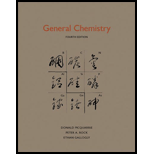
Concept explainers
(a)
Interpretation:
The net ionic equation for the double displacement of
Concept Introduction:
Net ionic equation: A chemical equation, which lists only those species taking part in the reaction is called as net ionic equation. The net ionic equation is used in acid-base neutralization reactions, double replacement
Spectator ions: A spectator ion is one, which exists, in the same form on both the reactant and product sides of a
(a)
Answer to Problem 10.44P
The net ionic equation is,
Explanation of Solution
Solutions of silver nitrate and sodium sulphide react to form silver sulphide and sodium nitrate. This is a double replacement reaction. The complete equation is,
The balanced equation is,
The complete ionic equation is,
The spectator ions,
The net ionic equation is written as,
(b)
Interpretation:
The net ionic equation for the double replacement reaction of
Concept Introduction:
Refer to part (a).
(b)
Answer to Problem 10.44P
The net ionic equation is,
Explanation of Solution
Solutions of sulphuric acid and lead nitrate react to form lead sulphate and nitric acid. This is a double replacement reaction. The complete equation is,
The balanced equation is,
The complete ionic equation is,
The spectator ions,
The net ionic equation is written as,
(c)
The net ionic equation for the double displacement reaction of
Concept Introduction:
Refer to part (a).
(c)
Answer to Problem 10.44P
The net ionic equation is,
Explanation of Solution
Solutions of mercury (II) nitrate and sodium iodide react to form mercury iodide and sodium nitrate. This is double replacement reaction. The complete equation is,
The balanced equation is,
The complete ionic equation is,
The spectator ions,
The net ionic equation is written as,
(d)
The net ionic equation for the reaction of
Concept Introduction:
Refer to part (a).
(d)
Answer to Problem 10.44P
The net ionic equation is,
Explanation of Solution
Solutions of cadmium chloride and silver perchlorate react to form cadmium perchlorate and silver chloride. The complete equation is,
The balanced equation is,
The complete ionic equation is,
The spectator ions,
The net ionic equation is,
The above net ionic equation is reduced to,
Want to see more full solutions like this?
Chapter 10 Solutions
General Chemistry
 ChemistryChemistryISBN:9781305957404Author:Steven S. Zumdahl, Susan A. Zumdahl, Donald J. DeCostePublisher:Cengage Learning
ChemistryChemistryISBN:9781305957404Author:Steven S. Zumdahl, Susan A. Zumdahl, Donald J. DeCostePublisher:Cengage Learning ChemistryChemistryISBN:9781259911156Author:Raymond Chang Dr., Jason Overby ProfessorPublisher:McGraw-Hill Education
ChemistryChemistryISBN:9781259911156Author:Raymond Chang Dr., Jason Overby ProfessorPublisher:McGraw-Hill Education Principles of Instrumental AnalysisChemistryISBN:9781305577213Author:Douglas A. Skoog, F. James Holler, Stanley R. CrouchPublisher:Cengage Learning
Principles of Instrumental AnalysisChemistryISBN:9781305577213Author:Douglas A. Skoog, F. James Holler, Stanley R. CrouchPublisher:Cengage Learning Organic ChemistryChemistryISBN:9780078021558Author:Janice Gorzynski Smith Dr.Publisher:McGraw-Hill Education
Organic ChemistryChemistryISBN:9780078021558Author:Janice Gorzynski Smith Dr.Publisher:McGraw-Hill Education Chemistry: Principles and ReactionsChemistryISBN:9781305079373Author:William L. Masterton, Cecile N. HurleyPublisher:Cengage Learning
Chemistry: Principles and ReactionsChemistryISBN:9781305079373Author:William L. Masterton, Cecile N. HurleyPublisher:Cengage Learning Elementary Principles of Chemical Processes, Bind...ChemistryISBN:9781118431221Author:Richard M. Felder, Ronald W. Rousseau, Lisa G. BullardPublisher:WILEY
Elementary Principles of Chemical Processes, Bind...ChemistryISBN:9781118431221Author:Richard M. Felder, Ronald W. Rousseau, Lisa G. BullardPublisher:WILEY





